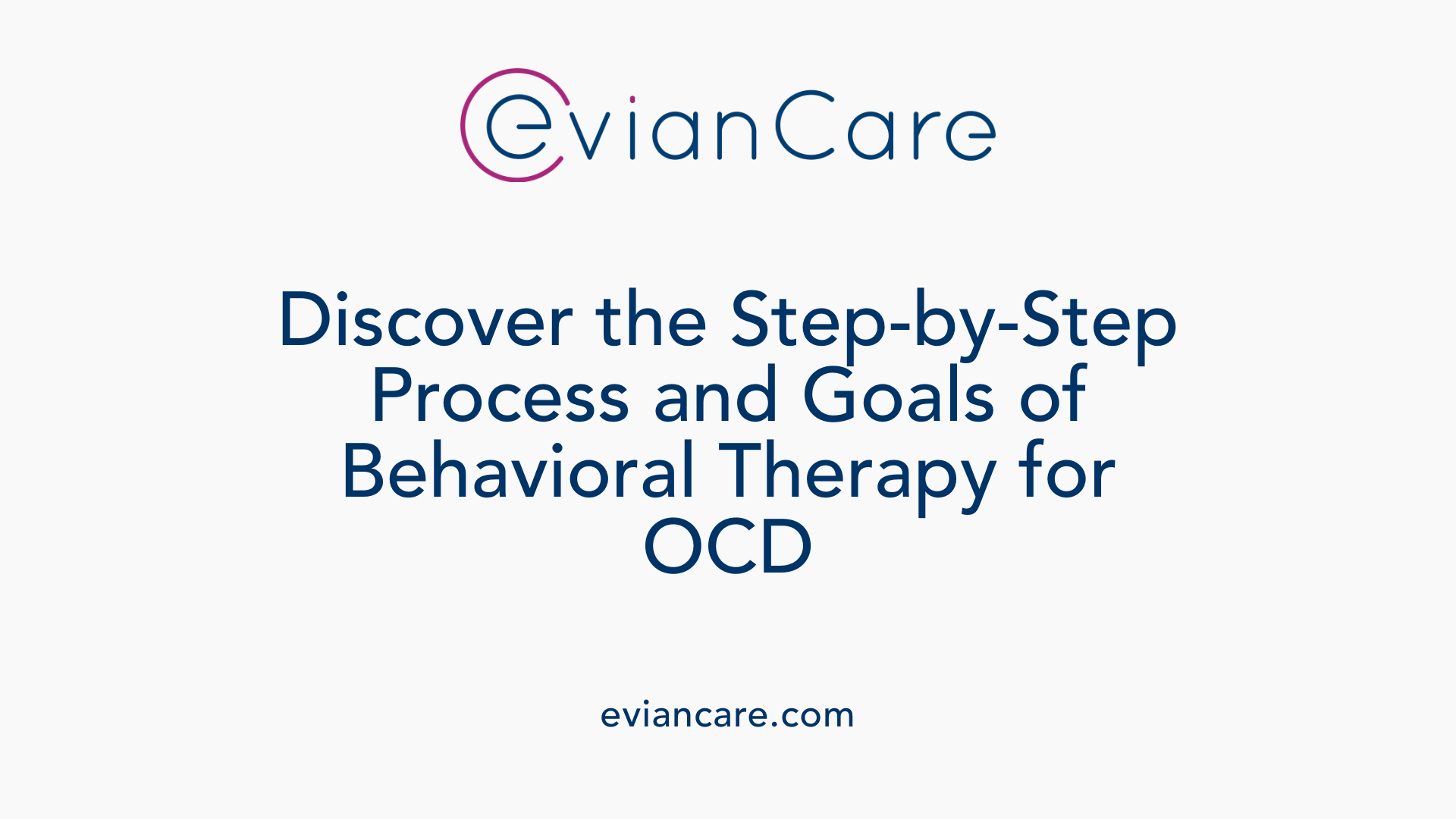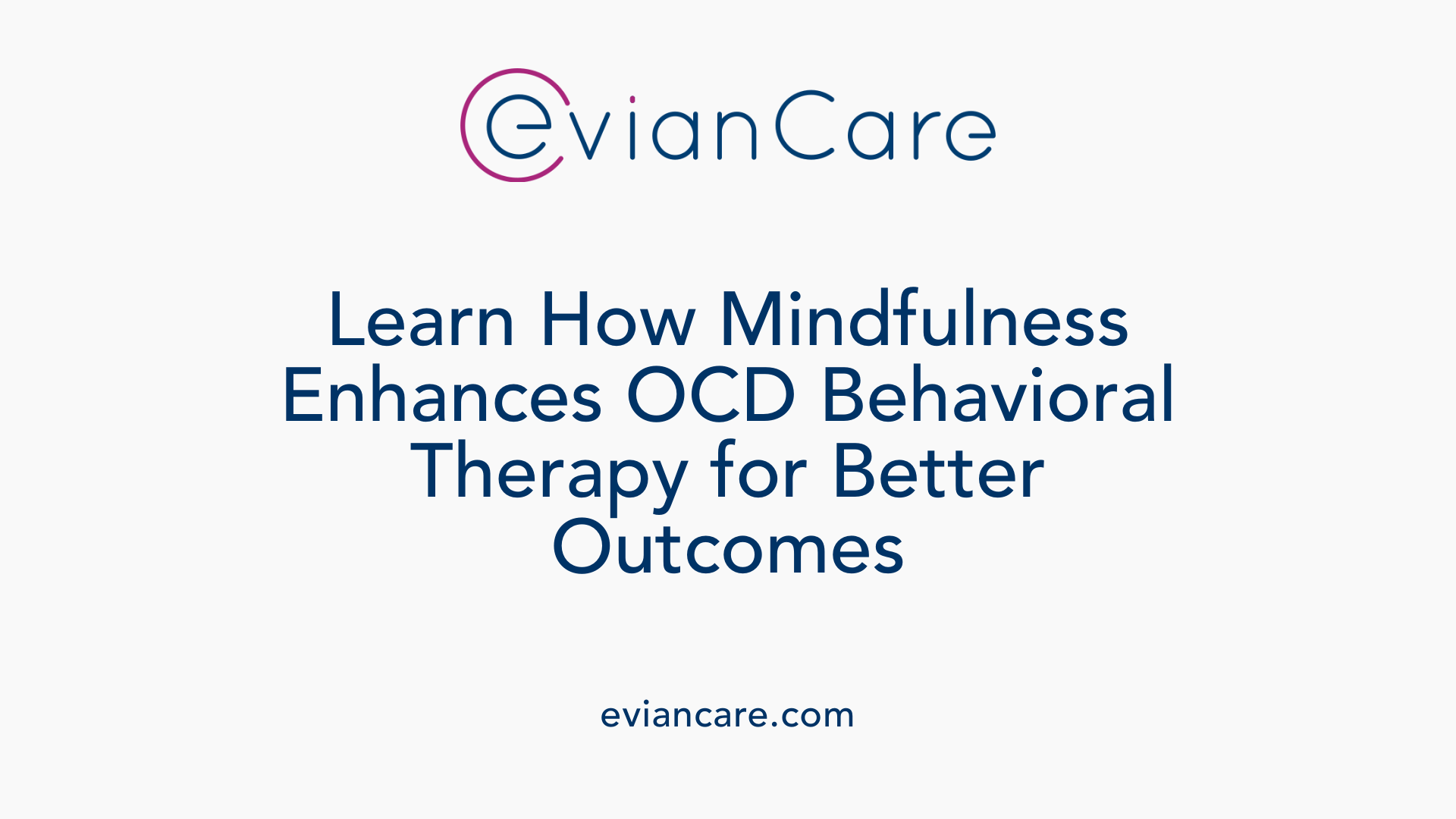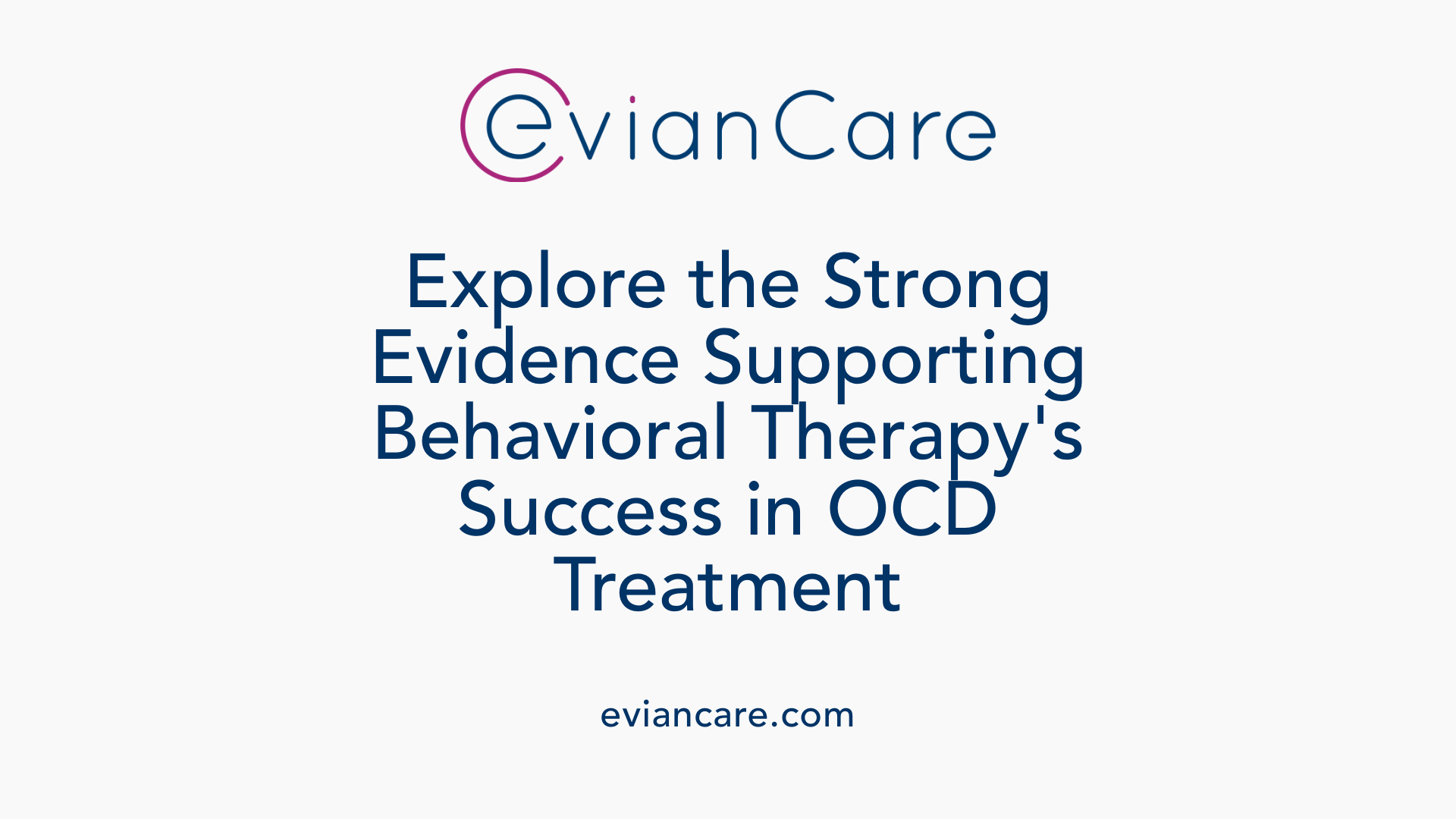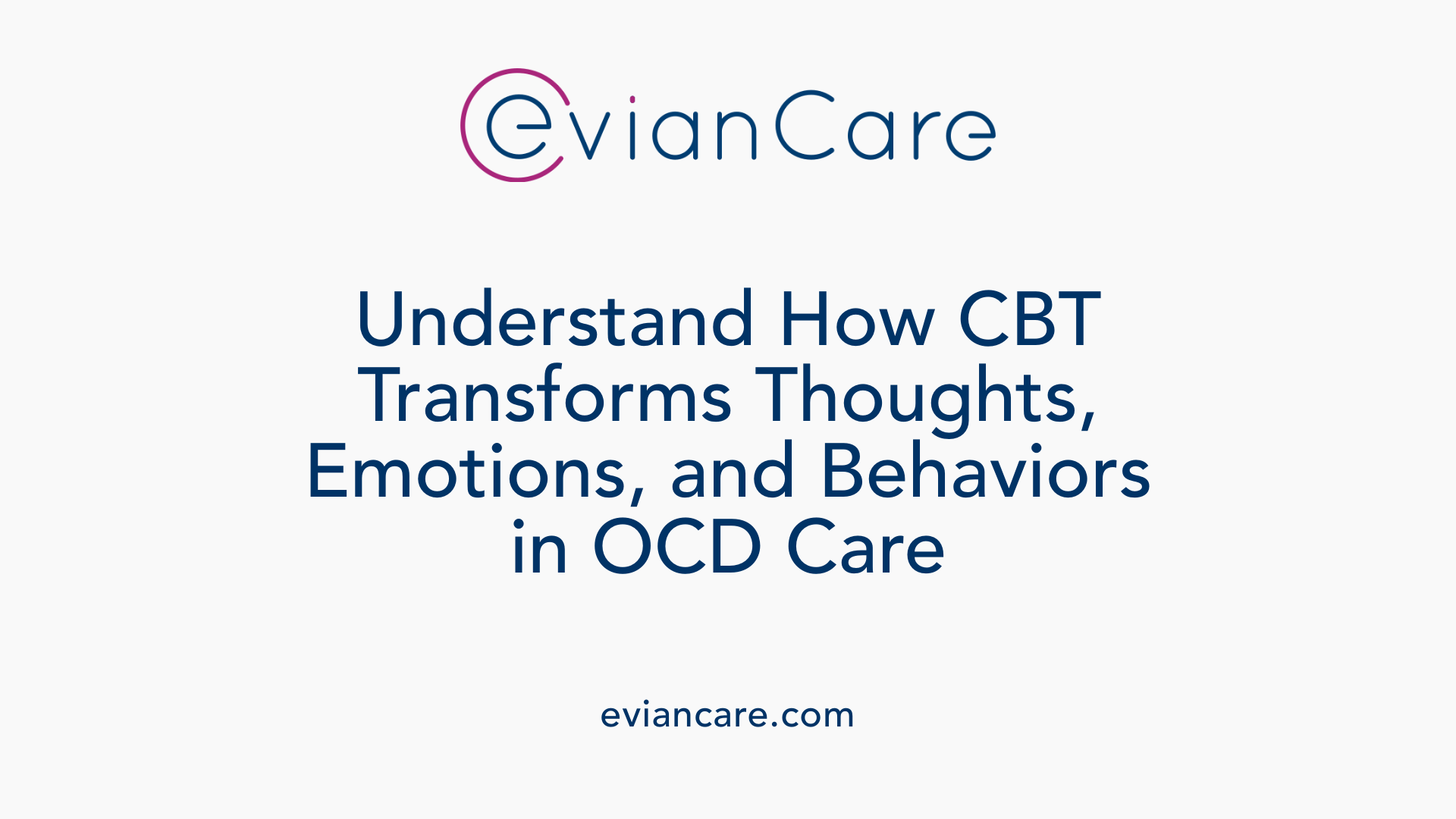
Understanding Behavioral Interventions in OCD Management
Obsessive-Compulsive Disorder (OCD) is a challenging condition characterized by persistent intrusive thoughts and compulsive behaviors. Behavioral therapy, especially Cognitive-Behavioral Therapy (CBT) with exposure and response prevention (ERP), stands out as a highly effective, evidence-based approach. This article explores the process, techniques, principles, and outcomes of behavioral therapy in managing OCD symptoms, emphasizing the integration of mindfulness and cognitive strategies to enhance treatment efficacy.
The Core Process and Goals of Behavioral Therapy for OCD

What is the typical process and goal of behavioral therapy for OCD?
Behavioral therapy for OCD is centered around a well-established intervention known as Exposure and Response Prevention (ERP). This structured approach involves systematically exposing individuals to situations, objects, or thoughts that trigger their obsessions, while actively preventing them from performing compulsive rituals. The process is often gradual, beginning with exposures to less distressing stimuli and progressing toward more challenging triggers.
The primary goal of ERP is to help patients recognize that their obsessive thoughts and urges are symptoms of OCD, not actual threats. By resisting compulsive behaviors, individuals learn that their anxiety diminishes naturally over time—a phenomenon known as habituation. This process reduces the power of the obsessions and breaks the cycle of compulsions.
Therapists typically tailor treatment to each individual's unique symptom profile. They might construct an exposure hierarchy that ranks feared stimuli from least to most distressing. Throughout therapy, patients increase their distress tolerance by confronting these triggers without resorting to compulsions.
In addition to ERP, comprehensive behavioral treatment may include psychoeducation about OCD, cognitive strategies such as relabeling and reframing maladaptive beliefs, and techniques to enhance coping skills. When suitable, medication—particularly selective serotonin reuptake inhibitors (SSRIs)—may be integrated to address severe symptoms.
Overall, the primary aim of behavioral therapy for OCD is to reduce the severity and frequency of obsessions and compulsions, improve functioning, and provide patients with the tools necessary to manage their symptoms independently over the long term.
How does understanding and restructuring beliefs fit into the process?
Cognitive components are often incorporated alongside behavioral techniques to address underlying maladaptive beliefs. For example, patients might learn to challenge perceptions that certain objects are truly dangerous or that performing rituals is the only way to prevent harm. This cognitive restructuring reinforces the behavioral work by changing how individuals interpret their thoughts and fears.
By promoting acceptance of uncertainty and discomfort, therapy encourages patients to lean into anxiety rather than avoid it. This acceptance helps diminish avoidance behaviors and increases resilience in the face of obsessive triggers.
In conclusion, behavioral therapy for OCD combines exposure to feared stimuli, prevention of compulsions, cognitive restructuring, and acceptance strategies to achieve remission of symptoms and improve quality of life.
Incorporating Mindfulness into OCD Behavioral Therapy

How can mindfulness strategies be incorporated into behavioral therapy for OCD?
Mindfulness strategies can be effectively integrated into OCD treatment, especially within cognitive-behavioral therapy (CBT) that includes exposure and response prevention (ERP). This involves teaching patients to observe their intrusive thoughts, feelings, and bodily sensations without judgment. Such non-reactive awareness fosters acceptance of internal experiences, reducing the tendency to fight or suppress distress.
Clients learn various mindfulness techniques, including present-moment awareness, meditation, and focused attention, often centered on the breath or bodily sensations. These practices help individuals recognize that obsessive thoughts are transient and do not necessarily require action. During ERP exercises, mindfulness supports patients in staying engaged with the present moment, tolerating discomfort, and resisting the urge to perform compulsions.
The incorporation of mindfulness provides additional tools to manage emotional responses. It enhances emotional regulation by increasing awareness of the emotional states linked to obsessions and compulsions. Moreover, mindfulness strengthens distress tolerance, enabling patients to withstand anxiety-provoking situations without resorting to rituals.
Integrating mindfulness into therapy complements traditional behavioral techniques by shifting the focus from trying to eliminate thoughts to developing a healthier relationship with them. By accepting intrusive thoughts as passing mental events rather than threats, patients often experience a decrease in the power and frequency of compulsions.
Research supports that this combined approach not only improves the efficacy of exposure exercises but also enhances long-term treatment outcomes. Patients become more resilient in facing their fears, leading to decreased OCD symptoms and improved quality of life.
In summary, mindfulness strategies in OCD therapy help individuals accept their internal experiences, promote present-moment awareness, and bolster emotional regulation. These benefits make ERP more tolerable and effective, ultimately fostering greater symptom normalization and sustained recovery.
Evidence Supporting the Effectiveness of Behavioral Therapy in OCD

What is the effectiveness of behavioral therapy in managing OCD symptoms?
Behavioral therapy, especially through techniques like Exposure and Response Prevention (ERP), has a robust evidence base confirming its efficacy in treating obsessive–compulsive disorder (OCD). Research spanning multiple controlled trials demonstrates that ERP, combined with cognitive strategies addressing acceptance, leads to significant reductions in symptoms.
Meta-analyses, which compile data from numerous studies, reveal large effect sizes indicating substantial clinical benefit. For example, a meta-analysis involving over 1,700 participants reported an average effect size of approximately g=−0.59 on the Yale–Brown Obsessive-Compulsive Scale (Y–BOCS), reflecting a marked decrease in OCD severity post-treatment. The effectiveness of CBT with ERP is well-supported across age groups, including children, adolescents, and adults, making it a versatile and reliable treatment option.
What are the remission and response rates?
The remission rates associated with behavioral therapy are notable. Studies report that approximately 56–59% of patients achieve significant symptom remission, demonstrating that more than half of individuals undergoing ERP experience a clinically meaningful reduction in OCD symptoms. Response rates are even higher, with about 65–75% of patients experiencing much-improved or improved conditions following treatment.
This high response rate underscores how effective behavioral therapy can be—many individuals find relief from their symptoms significantly improved, enhancing their quality of life.
How durable are the long-term benefits?
The durability of treatment effects is another crucial aspect. Follow-up studies indicate that the gains achieved through ERP are sustained over time, with about 65–75% of patients maintaining their improvements at long-term assessments. Although some individuals may experience a relapse or residual symptoms, long-term data affirm that the majority continue to benefit from initial therapy.
Moreover, combining ERP with cognitive interventions emphasizing acceptance has been shown to reduce treatment drop-out rates—currently very low at around 7%. This suggests that incorporating acceptance strategies not only enhances efficacy but also helps patients stay engaged with their treatment plans.
Overall, the evidence confirms that behavioral therapy, particularly ERP within CBT, provides a highly effective, durable, and safe approach to managing OCD. Patients are likely to experience substantial symptom reduction that can last years after completing therapy, supporting its position as the front-line treatment.
| Aspect | Findings | Additional Details |
|---|---|---|
| Effect sizes | Large (g≈−0.59) in meta-analyses | Indicates major symptom reductions |
| Response rates | 65–75% of patients improved | Measurements include scales like Y–BOCS |
| Remission rates | About 56–59% achieved symptom remission | Reaching low or normal levels of symptoms |
| Long-term benefits | 65–75% maintained improvements over time | Some may experience residual or mild symptoms |
| Dropout and refusal rates | Very low (refusal: 2.3%; dropout: 7%) | Acceptance strategies improve adherence |
This compelling body of evidence positions behavioral therapy, especially ERP, as the gold standard for OCD treatment, with proven, lasting benefits for most individuals affected by this disorder.
How CBT Addresses OCD by Changing Thoughts, Emotions, and Behaviors

How does cognitive-behavioral therapy (CBT) help treat OCD?
Cognitive-behavioral therapy (CBT) plays a crucial role in treating obsessive-compulsive disorder (OCD) by directly targeting the problematic thoughts, feelings, and actions that maintain the disorder. It is based on the idea that changing maladaptive patterns of thinking and behaving can significantly reduce OCD symptoms.
A central component of CBT for OCD is exposure and response prevention (ERP). This technique involves gradually exposing individuals to feared stimuli—either in real life or through vivid imagination—without allowing them to perform compulsive rituals. Over time, this process helps the brain become desensitized to anxiety-provoking triggers, weakening the link between intrusive thoughts and compulsive behaviors.
Besides exposure, CBT employs cognitive restructuring techniques. These are designed to challenge and modify dysfunctional beliefs, such as fears of contamination or the need for absolute certainty. Patients learn to view their obsessive thoughts as normal mental events rather than facts requiring immediate action. Acceptance-based strategies are also integrated, helping individuals tolerate uncertainty and intrusive thoughts without reacting compulsively.
Typically, CBT for OCD is conducted over about 12 to 22 weekly sessions. Patients are encouraged to practice skills learned during therapy outside of sessions, such as exposing themselves to feared situations or refraining from rituals. This active involvement promotes lasting change.
Research provides strong evidence supporting the efficacy of CBT, particularly ERP, for OCD treatment. Studies indicate that most patients experience significant symptom reduction, often with minimal risk or side effects. This makes CBT, especially with its focus on exposure and cognitive restructuring, a frontline, highly recommended approach in managing OCD.
In summary, CBT helps individuals break the cycle of obsessions and compulsions by promoting adaptive responses, challenging dysfunctional beliefs, and fostering acceptance of uncertainty, ultimately leading to a substantial decrease in OCD symptoms.
Principles and Techniques of Behavioral Therapy for OCD
What are the principles and techniques of behavioral therapy for obsessive-compulsive disorder (OCD)?
Behavioral therapy for OCD is grounded in the principle of systematically exposing individuals to their fears or triggers in a controlled environment, while preventing the ritualistic responses that temporarily relieve anxiety. This approach is known as Exposure and Response Prevention (ERP), which aims to weaken the connection between obsessive thoughts and compulsive behaviors, promoting habituation and reducing overall symptom severity.
The core technique involves exposing patients to stimuli or situations that provoke their obsessions. These exposures can be in real life (in vivo exposure) or imagined scenarios (imaginal exposure). During in vivo exposure, patients confront actual feared objects or settings, such as touching contaminated surfaces or checking locks repeatedly until their anxiety diminishes. Imaginal exposure involves vividly visualizing feared situations, especially useful when real-life confrontation is impractical.
Ritual response prevention is a vital component, encouraging patients to resist compulsive behaviors like excessive cleaning, checking, or reassurance seeking. This process helps patients learn that anxiety can decrease naturally over time without performing rituals, breaking the compulsive cycle.
In addition to exposure-based techniques, cognitive interventions are integrated into behavioral therapy. Cognitive restructuring challenges distorted beliefs, such as viewing the world as inherently dangerous, and replaces these thoughts with more realistic perspectives. Inference-based CBT helps patients re-evaluate thoughts based on evidence and reduce the emotional influence of intrusive thoughts.
Acceptance strategies, including mindfulness, are also incorporated. These techniques teach patients to observe and accept unwanted thoughts and feelings without judgment, which diminishes their power and reduces avoidance behaviors.
Furthermore, other behavioral techniques bolster treatment. Journaling helps track obsessive patterns and progress. Activity scheduling encourages engagement in meaningful activities, which can reduce compulsive cycles linked to boredom or reassurance seeking. Psychoeducation provides understanding about OCD mechanisms, empowering patients to actively participate in their recovery.
When behavioral therapy is combined with medication, such as SSRIs, or with advanced neuromodulation techniques in severe cases (like Transcranial Magnetic Stimulation or Deep Brain Stimulation), it offers a comprehensive strategy. This multifaceted approach addresses both the behavioral and neurochemical aspects of OCD, significantly enhancing treatment outcomes.
Overall, these principles and techniques work synergistically to diminish compulsions, foster resilience to anxiety, and facilitate long-term symptom management.
The Role of Beliefs and Cognitive Restructuring in OCD Treatment
What is the role of cognitive restructuring in behavioral therapy for OCD?
Cognitive restructuring is a vital component of contemporary behavioral therapy approaches, especially within Cognitive Behavioral Therapy (CBT) for OCD. It focuses on identifying and modifying maladaptive beliefs that sustain obsessive-compulsive behaviors.
In the context of OCD, patients often hold dysfunctional beliefs such as viewing the world as inherently dangerous, feeling an exaggerated sense of responsibility for preventing harm, or believing that certain rituals are essential for safety. These distorted thoughts reinforce compulsive behaviors and maintain a cycle of distress.
Cognitive restructuring aims to challenge these beliefs systematically. Therapists guide patients to recognize their irrational thoughts, evaluate their validity, and develop more balanced perspectives. They employ various exercises—including thought records, behavioral experiments, and cognitive reframing—to help individuals see that their fears and beliefs are often exaggerated, unfounded, or based on cognitive distortions.
This process not only diminishes the emotional impact of intrusive thoughts but also reduces the perceived need for compulsions as a form of neutralizing threat. When patients start to believe that the world is less dangerous than their catastrophic beliefs suggest and that their rituals are not the only way to ensure safety, they become less compelled to perform compulsive acts.
Furthermore, by transforming dysfunctional beliefs, cognitive restructuring enhances the efficacy of behavioral interventions such as exposure and response prevention (ERP). It also supports emotional regulation and resilience, enabling patients to respond to intrusive thoughts with acceptance rather than compulsive reactions.
Overall, cognitive restructuring strengthens the therapeutic process, fostering long-term management of OCD symptoms and preventing relapse. It encourages a shift from unhelpful, rigid beliefs to healthier, realistic ones that are compatible with a life free of compulsions.
How does restructuring beliefs influence behavior and emotional responses?
When beliefs are challenged and changed, patients often experience a corresponding decrease in the anxiety and distress associated with OCD. They learn to tolerate uncertainty and accept intrusive thoughts without acting on them.
This shift helps reduce compulsive behaviors, as the motivation to perform rituals diminishes when the perceived threat is lessened.
Emotionally, individuals tend to feel more in control and less overwhelmed by their symptoms. They develop better emotional resilience and are less likely to engage in avoidance or reassurance-seeking, behaviors that typically reinforce OCD.
In summary, cognitive restructuring transforms the way individuals perceive and respond to their obsessions, leading to meaningful behavioral change and emotional well-being. It is a cornerstone of effective OCD treatment, often combined with exposure techniques to achieve optimal results.
Supporting Factors for OCD Treatment Success
How does family involvement affect OCD treatment outcomes?
Involving family members in OCD treatment can significantly improve the chances of success. Family accommodation, where relatives participate in compulsive rituals or enable avoidance behaviors, often maintains or exacerbates OCD symptoms. Reducing these accommodations through family therapy and psychoeducation helps patients practice healthier behaviors. The Family Accommodation Scale is used to assess and address these behaviors, encouraging family members to support exposure exercises and avoid reinforcing compulsions.
What qualities should therapists have to enhance treatment effectiveness?
Therapists play a crucial role in the success of OCD therapy. Respectful, encouraging, and supportive therapists foster a safe environment for exposure and response prevention (ERP). Treatment adherence improves when therapists build strong rapport, explaining the rationale behind exercises and actively involving patients in designing exposure hierarchies. Structured and patient-centered approaches, alongside the ability to tailor exercises to individual needs, optimize outcomes.
How does patient engagement influence the success of cognitive-behavioral therapy?
Active patient engagement—participating fully in therapy, completing homework, and practicing exposure tasks—is vital. Patients who adhere to prescribed exercises and maintain motivation typically experience greater symptom reduction. Engagement can be enhanced through psychoeducation on OCD mechanisms, emphasizing that intrusive thoughts are normal and that avoidance worsens symptoms. Moreover, fostering a belief in the therapy process and emphasizing the importance of consistent effort help increase adherence.
How do integration strategies with medication impact treatment success?
Combining pharmacotherapy—especially selective serotonin reuptake inhibitors (SSRIs)—with cognitive-behavioral therapy (CBT) and ERP often yields better results for severe or treatment-resistant OCD cases. This integrated approach leverages medication's capacity to reduce anxiety, enabling patients to engage more effectively in exposure exercises. Clinical guidelines endorse this combination, with ongoing monitoring to tailor treatment plans.
Additional factors influencing OCD treatment outcomes
Various individual and contextual factors influence the success of OCD treatment. These include pre-treatment symptom severity, comorbid conditions like depression or schizotypal personality disorder, family dynamics, and socioeconomic support. Therapist expertise, treatment integrity, and the use of evidence-based protocols also critically affect efficacy.
| Factors | Description | Impact |
|---|---|---|
| Family involvement | Reducing accommodation and promoting supportive behaviors | Enhances adherence and reduces maintenance of compulsions |
| Therapist qualities | Supportiveness, expertise, and rapport-building | Improves engagement and treatment efficiency |
| Patient engagement | Active participation and homework compliance | Leads to greater symptom improvement |
| Pharmacotherapy integration | Combining medication with therapy | Especially beneficial in severe or resistant cases |
| Individual patient factors | Severity, comorbidities, motivation | Modulate overall treatment outcomes |
| Treatment protocols adherence | Use of evidence-based techniques and therapist training | Ensures consistent and effective therapy delivery |
Research shows that when these factors are optimized, OCD treatment outcomes improve markedly. Effective family involvement reduces rituals, a skilled therapist guides and motivates the patient, and the combined use of medications with CBT and ERP addresses both biological and psychological components. Personalizing therapy based on individual needs ensures the best chance for symptom remission and long-term management.
Managing Treatment Resistance and Severe Cases
What are second-line and third-line treatments for OCD?
For some individuals with obsessive–compulsive disorder (OCD), standard therapies like cognitive-behavioral therapy (CBT) with exposure and response prevention (ERP), or medication with selective serotonin reuptake inhibitors (SSRIs), may not lead to sufficient improvements. In such cases, clinicians consider second-line and third-line treatments.
Second-line treatments include adjunctive therapies like Acceptance and Commitment Therapy (ACT), additional cognitive therapy techniques, Dialectical Behavior Therapy (DBT), and guided self-help approaches. Medications such as serotonin-norepinephrine reuptake inhibitors (SNRIs) or clomipramine, a tricyclic antidepressant, may also be added.
Third-line treatments are reserved for highly treatment-resistant cases. These include neuromodulation techniques like Transcranial Magnetic Stimulation (TMS), Deep Brain Stimulation (DBS), and occasionally, neurosurgical procedures such as anterior cingulotomy or capsulotomy.
| Treatment Level | Options | Description |
|---|---|---|
| Second-line | Additional CBT, ACT, SNRIs, clomipramine | Enhanced psychosocial and pharmacological strategies for partial responders. |
| Third-line | TMS, DBS, neurosurgery | For severe, persistent OCD unresponsive to other interventions. |
What are extended and intensive therapy options?
Severe OCD cases often require more prolonged or frequent therapy sessions. Traditional weekly sessions may be supplemented with intensive residential or day programs. Intensive CBT programs typically involve daily therapy lasting from one to several weeks.
Extended therapy might include ongoing booster sessions following initial treatment to maintain gains and prevent relapse. Some clinics offer multi-hour daily exposure and response prevention exercises, often in inpatient or outpatient settings.
The advantage of these approaches is the ability to work intensively on complex or longstanding OCD symptoms, addressing underlying fears and maladaptive habits more thoroughly.
How can therapy be combined with medication?
Combining CBT with medication, particularly SSRIs or clomipramine, often yields better outcomes than either approach alone. Medication can reduce overall anxiety levels and facilitate engagement in therapy.
This integrative approach is especially beneficial in severe cases where symptoms are pervasive or resistant to initial treatment.
Research suggests that the combination may produce a synergistic effect, leading to higher remission rates and longer-lasting benefits.
| Treatment Strategy | Benefits | Considerations |
|---|---|---|
| CBT + Medication | Higher likelihood of symptom improvement; lower relapse risk | Requires careful monitoring for side effects and interactions |
| Intensive combined therapy | Addresses persistent symptoms more effectively | Usually requires access to specialized treatment centers |
Why are these approaches important?
Some individuals with OCD do not respond to first-line treatments within expected timeframes. For them, exploring second or third-line options is crucial for achieving meaningful symptom relief.
Extending therapy duration and employing complementary treatments can significantly enhance quality of life, reduce compulsive behaviors, and help regain functional independence.
Treatment-resistant OCD management remains a dynamic and evolving field, with ongoing research into innovative therapies and personalized approaches.
By tailoring interventions to individual needs, clinicians aim to provide the most effective pathway to recovery, even in the most complex cases.
This comprehensive approach ensures that severely affected patients receive the intensive support necessary to break free from OCD's grip, paving the way for lasting change and improved well-being.
Empowering Long-Term Management of OCD
Behavioral therapy, especially CBT incorporating ERP, acceptance, and mindfulness strategies, offers a powerful, evidence-based approach to managing OCD. Its structured nature, focus on exposure, and cognitive interventions enable individuals to confront fears, resist compulsions, and develop healthier thought patterns. When delivered with skilled therapists and integrated with pharmacotherapy and family support, behavioral therapy can lead to meaningful, lasting improvements. Ongoing research and clinical advances continue to refine these techniques, providing hope for those living with OCD to regain control and improve their quality of life.
References
- Cognitive–Behavioral Treatment of Obsessive–Compulsive Disorder
- Understanding CBT for OCD | Center for the Treatment and Study of ...
- Treatments for OCD | Anxiety and Depression Association of ...
- Cognitive-Behavioral Therapy for Obsessive-Compulsive Disorder
- What is Cognitive Behavioural Therapy (CBT)? - OCD-UK
- Behavior Therapy | Obsessive-Compulsive and Related Disorders
- OCD (Obsessive-Compulsive Disorder): Symptoms & Treatment
- Mindfulness and Cognitive Behavioral Therapy for OCD
- Behavior Therapy for Obsessive-Compulsive Disorder
- Treatment - Obsessive compulsive disorder (OCD) - NHS












